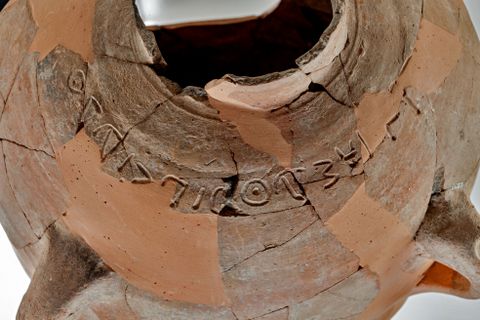
JERUSALEM — A rare inscription on a pottery shard that was unearthed in Israel in 2012 has finally been deciphered and has been found to correlate with the time of King David.
The fragment was among a number of pieces excavated from the Valley of Elah, or Khirbet Qeiyafain, the location believed to be where the then-teenage David fought the giant Goliath of Gath. The discovery is accredited to Professor Yosef Garfinkel of the Institute of Archaeology of Hebrew University and Saar Ganor of the Israel Antiquities Authority.
As there was writing on a number of the fragments—believed to be in the ancient Canaanite language, the archaeologists were intrigued. The Antiquities Authority began working to piece the shards back together to re-form the jar.
Once the project was completed, it was found that the letters formed whole words, which then needed to be deciphered. Dr. Mitka Golub and Dr. Haggai Misgav translated the jar as reading “Eshba’al Ben Bada,” with Eshba’al being a name that researchers believe was limited to the 10th century B.C.
“This is the first time that the name Eshbaʽal has appeared on an ancient inscription in the country,” Garfinkel and Ganor said in a statement released by the Israel Antiquities Authority. “It is interesting to note that the name Eshba’al appears in the Bible, and now also in the archaeological record, only during the reign of King David, in the first half of the tenth century BCE.”
“This name was not used later in the First Temple period,” they continued. “The correlation between the biblical tradition and the archaeological finds indicates this was a common name only during that period. The name Bedaʽ is unique and does not occur in ancient inscriptions or in the biblical tradition.”
Garfinkel and Ganor note that the name is listed in the Book of 1 Chronicles in the Jewish Tanakh (known as the Old Testament by Christians).
“In II Samuel there was apparently reluctance to use the name Eshba’al, which was reminiscent of the Canaanite storm god Ba’al, and the original name was therefore changed to Ish-Bashat, but the original name of Eshba’al was preserved in the Book of Chronicles,” they outlined. “Thus, for example, the name of the warlord Gideon Ben Joash was also changed from Jerrubaal to Jerubesheth.”
While Eshba’al was the name of King Saul’s son, who reigned over Israel after his father and brothers perished in the Battle of Gilboa (1 Chronicles 8:33, 1 Samuel 31), the pottery is not believed to belong to the former king, as it would have read “Eshba’al Ben Shaul.” However, researchers strongly believe that the pottery dates back to the 10th century B.C. and that it belonged to an important man who felt the need to inscribe his name on his belongings.
The men state that the find and inscription is an enlightening contribution as they study the past.
“Until about five years ago we knew of no inscriptions dating to the tenth century BCE from the Kingdom of Judah. In recent years, four inscriptions have been published: two from Khirbet Qeiyafa, one from Jerusalem and one from Bet Shemesh,” Garfinkel and Ganor explained. “This completely changes our understanding of the distribution of writing in the Kingdom of Judah and it is now clear that writing was far more widespread than previously thought.”
“It seems that the organization of the kingdom required a cadre of clerks and writers and their activity is also manifested in the appearance of inscriptions,” they said.
Become a Christian News Network Supporter...


